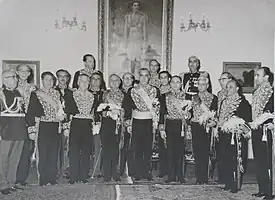Manouchehr Eghbal | |
|---|---|
 | |
| 37th Prime Minister of Iran | |
| In office 3 April 1957 – 1 September 1960 | |
| Monarch | Mohammad Reza Shah |
| Preceded by | Hossein Ala' |
| Succeeded by | Jafar Sharif-Emami |
| Personal details | |
| Born | September 1909 Mashhad, Qajar Iran |
| Died | 25 November 1977 (aged 67–68) Tehran, Pahlavi Iran |
| Political party |
|
| Spouse | Alice Eghbal |
| Children | 3 |
| Alma mater | |
Manouchehr Eghbal (Persian: منوچهر اقبال; September 1909 – 25 November 1977) was an Iranian physician and royalist politician. He was the Prime Minister of Iran from 1957 to 1960.
Early life and education
Eghbal was born in Mashhad in September 1909,[1][2] and his family were from Khorasan.[3] He had an older brother, Ali.[2]
Eghbal studied at Darolfonoon.[3] He finished his advanced studies in medicine at the University of Paris in 1933.[1]
Career and activities

Following his graduation in 1933 Eghbal was employed as a physician in Mashhad.[3] During the 1940s he was made deputy health minister.[3] He was a member of the French Academy of Medicine.[1] He was named as the undersecretary of the Ministry of Health in 1943.[2] In 1950, Eghbal was appointed chancellor of Tabriz University. He was named as the governor of Azerbaijan in 1950 and held the post until 1952.[1] He became chancellor of Tehran University in 1954.[1] Five years later he became Iran's envoy to UNESCO. He then taught at Sorbonne for a while and became a member of the French Académie Nationale de Médecine. During this period he founded the Nationalists' Party[4] and served as the party's chair.[5]
Eghbal was appointed minister of health in the cabinet led by Mohammad Sa'ed in 1944.[2] He also held the same post in the cabinet led by Ahmad Qavam (1946).[2] Then he served as the minister of education in the cabinet of Abdolhossein Hazhir (1948),[6] minister of transportation in the cabinet led by Ali Mansur, and interior minister in the cabinet of Mohammad Sa'ed between 1948 and 1950.[7]
In April 1957, Eghbal became prime minister, replacing Hossein Ala' in the post.[7][8] Eghbal was also named as the chief of Plan Orgazination in February 1959 when Abol Hassan Ebtehaj resigned from office.[9] His cabinet lasted until September 1960,[10] and he was replaced by Jafar Sharif-Emami as prime minister.[11] Until his death, he served as the chairman of the National Iranian Oil Company.[12] He was also one of the close aides to the Shah and also, served as a board member of the royal organization of social welfare headed by Ashraf Pahlavi.[13][14]
Personal life and death
Eghbal married a French woman, Alice, during his studies in France.[1] They had three daughters.[15] The eldest Nicole became a nun.[15] The second, Monique, married a Swiss surgeon and had a daughter, Muriel Pedrazzini.[15] The youngest daughter, Maryam Francoise, first married Prince Mahmoud Reza Pahlavi in October 1964 when she was 18 years old,[16] but the marriage ended in divorce and she married Shahriar Shafiq.[15]
Eghbal died of a heart attack on 25 November 1977 in Tehran, aged 68.[17]
Honors
Eghbal was given the title of honorary doctorate by the University of Paris in 1959.[1] He was also awarded the same title by the University of Bordeaux.[1]
References
- 1 2 3 4 5 6 7 8 "Irail's Ex-Strong Man: Manouchehr Eghbal". The New York Times. 30 August 1960. p. 3. ProQuest 114933764. Retrieved 16 July 2023.
- 1 2 3 4 5 "File 11/44 Leading Personalities in Iraq, Iran & Saudi Arabia". Qatar Digital Library. 1948. Retrieved 17 August 2023.
Citing from the British India Office Records and Private Papers
- 1 2 3 4 James A. Bill (1988). The Eagle and the Lion. The Tragedy of American-Iranian Relations. New Haven, CT; London: Yale University Press. p. 102. doi:10.12987/9780300159516-006. ISBN 978-0-300-04412-6. S2CID 246116954.
- ↑ Leonard Binder (1962). Iran. Berkeley and Los Angeles, CA: University of California Press. p. 203. doi:10.1525/9780520317710. ISBN 9780520317710.
- ↑ Helmut Richards (September 1975). "America's Shah Shahanshah's Iran". MERIP Reports (40): 12. doi:10.2307/3011479. JSTOR 3011479.
- ↑ T. A. Votichenko (October 1948). "Developments of the Quarter: Comment and Chronology". The Middle East Journal. 2 (4): 454–455. JSTOR 4322013.
- 1 2 "Iran premier will quit". Schenectady Gazette. 2 April 1957. Retrieved 9 November 2012.
- ↑ "Iran minister resigns post". Gettysburg Times. Tehran. 3 April 1957. Retrieved 9 November 2012.
- ↑ Jay Walz (1 March 1959). "Iran's Plan put under premier. Shah's siding with his foes led to resignation of development chief". The New York Times. Tehran. p. 36. ProQuest 114686013. Retrieved 16 July 2023.
- ↑ Marvin Zonis (1971). Political Elite of Iran. Princeton, NJ: Princeton University Press. p. 129. doi:10.1515/9781400868803. ISBN 9781400868803.
- ↑ "Iran teachers' protest Iranian premier from office". The Press Courier. 5 May 1961. Retrieved 9 November 2012.
- ↑ Mehdi Zarghamee (2011). "Mojtahedi and the Founding of the Arya-Mehr University of Technology". Iranian Studies. 44 (5): 771. doi:10.1080/00210862.2011.570485. S2CID 145012971.
- ↑ "Ashraf Pahlavi". IICHS. Retrieved 4 March 2023.
- ↑ "Centers of Power in Iran" (PDF). CIA. May 1972. Retrieved 5 August 2013.
- 1 2 3 4 "Manouchehr Eghbal". Memim encyclopedia. Archived from the original on 8 January 2022.
- ↑ "People Make News". The Calgary Herald. 22 October 1964. Retrieved 9 November 2012.
- ↑ "Dr. Manouchehr Eghbal Iranian Ex‐Prime Minister". The New York Times. Tehran. Associated Press. 26 November 1977. Retrieved 8 January 2022.
Further reading
'Alí Rizā Awsatí. (2003). Iran in the Past Three Centuries (Irān dar Se Qarn-e Goz̲ashteh ), Volumes 1 and 2 (Paktāb Publishing, Tehran, Iran). ISBN 964-93406-6-1 (Vol. 1), ISBN 964-93406-5-3 (Vol. 2).
External links
 Media related to Manuchehr Eghbal at Wikimedia Commons
Media related to Manuchehr Eghbal at Wikimedia Commons